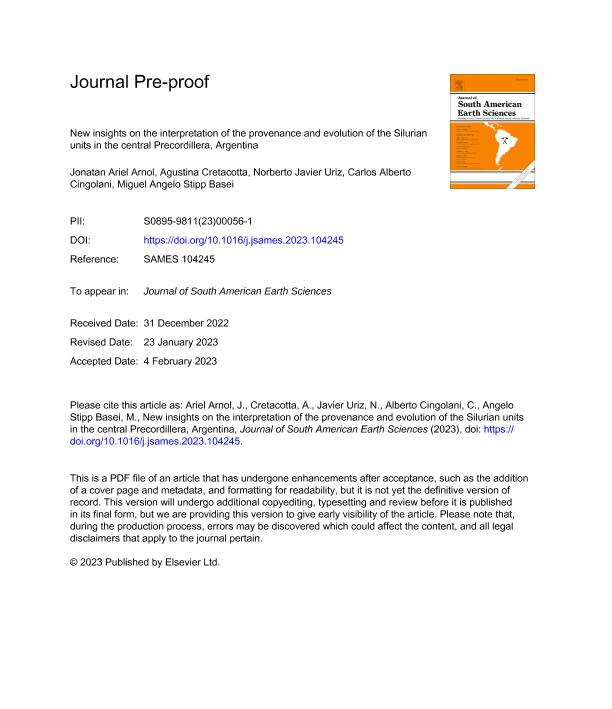Artículo
New insights on the interpretation of the provenance and evolution of the Silurian units in the central Precordillera, Argentina
Arnol, Jonatan Ariel ; Cretacotta, Agustina; Uriz, Norberto Javier; Cingolani, Carlos Alberto
; Cretacotta, Agustina; Uriz, Norberto Javier; Cingolani, Carlos Alberto ; Angelo Stipp Basei, Miguel
; Angelo Stipp Basei, Miguel
 ; Cretacotta, Agustina; Uriz, Norberto Javier; Cingolani, Carlos Alberto
; Cretacotta, Agustina; Uriz, Norberto Javier; Cingolani, Carlos Alberto ; Angelo Stipp Basei, Miguel
; Angelo Stipp Basei, Miguel
Fecha de publicación:
02/2023
Editorial:
Pergamon-Elsevier Science Ltd
Revista:
Journal of South American Earth Sciences
ISSN:
0895-9811
Idioma:
Inglés
Tipo de recurso:
Artículo publicado
Clasificación temática:
Resumen
In the central region of the Precordillera, San Juan Province, Silurian silicoclastic sedimentites of the Los Espejos Formation crop out in the Jáchal River area. To the south of this region, an equivalent unit is recognized in the San Juan River area (Tambolar Formation). Both units present similar lithological characteristics, however, it has not yet been defined if they share source areas of detrital contributions. On the other hand, for the Jáchal River sector, it is proposed to establish if there were changes in the regions from where the sub-basin received sediment contributions during the Devonian, which can be seen reflected in the detrital zircon contribution patterns of the overlying unit (Talacasto Formation). The present work is part of a series of studies tending to determine the nature and provenance of the Silurian-Devonian sequences of the Central Precordillera. On this occasion, detrital zircon patterns of the detrital sources of the Los Espejos Formation are analyzed and compared with the information obtained for the Silurian Tambolar Formation (San Juan River area) and the overlying Devonian Talacasto and Punta Negra formations (Jáchal and San Juan rivers areas). To characterize and compare the studied units, different methodologies were applied, namely sedimentary petrography, heavy minerals studies, and morphological and isotopic analyses of detrital zircons. The analysis of thin sections allowed determining textural and compositional parameters. Through the predominance of detrital minerals, it was possible to establish that the studied units are composed of quartzite-type rocks coming from mature areas, with low percentages of lithic components and abundant opaque heavy minerals of the hematite group. The study of heavy minerals, especially morphological and typological parameters of detrital zircons, allowed to establish recycled and plutonic sources as main modes, as well as the changes that occurred during the basin filling dynamics for Silurian and Devonian times. On the other hand, U–Pb isotopic analysis in detrital zircons indicate that the Pampean-Brasiliano orogenic cycle composes the main source of detritus with ages between 511 and 816 Ma. In second place are the Mesoproterozoic ages, represented by the interval from 1000 to 1350 Ma. The youngest detrital ages show a maximum sedimentation age of 478.5 ± 4.4 Ma (Tremadocian), indicating that younger sources of contribution correspond to the Famatinian Orogen. The Kolmogorov-Smirnoff test revealed that the studied Silurian-Devonian units studied have similar patterns of sedimentary contributions, which suggests that the sources of provenance were common in both regions and remained active throughout the entire time interval, without significant changes.
Archivos asociados
Licencia
Identificadores
Colecciones
Articulos(CCT - LA PLATA)
Articulos de CTRO.CIENTIFICO TECNOL.CONICET - LA PLATA
Articulos de CTRO.CIENTIFICO TECNOL.CONICET - LA PLATA
Citación
Arnol, Jonatan Ariel; Cretacotta, Agustina; Uriz, Norberto Javier; Cingolani, Carlos Alberto; Angelo Stipp Basei, Miguel; New insights on the interpretation of the provenance and evolution of the Silurian units in the central Precordillera, Argentina; Pergamon-Elsevier Science Ltd; Journal of South American Earth Sciences; 124; 2-2023; 1-13
Compartir
Altmétricas



